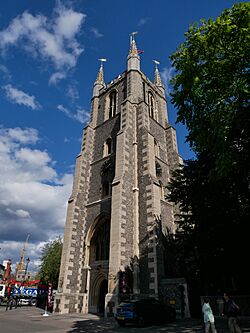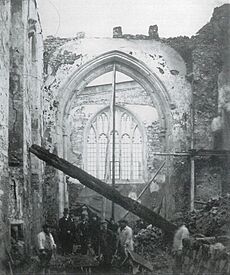Croydon Minster facts for kids
Quick facts for kids Croydon Minster |
|
|---|---|
| The Minster Church of St John Baptist at Croydon | |

Croydon Minster from the southwest
|
|
| Location | Old Town, Croydon |
| Country | England |
| Denomination | Church of England |
| Previous denomination | Catholic |
| Churchmanship | Liberal Catholic |
| Website | http://www.croydonminster.org/ |
| History | |
| Dedication | John the Baptist |
| Architecture | |
| Style | English Gothic |
| Administration | |
| Parish | Croydon |
| Deanery | Croydon Central deanery |
| Archdeaconry | Croydon archdeaconry |
| Episcopal area | Croydon area |
| Diocese | Diocese of Southwark |
Croydon Minster is a very important church in Croydon, a town in London, England. It's the main church for the area and is located in the Old Town. There are many churches in Croydon, but the Minster is the most well-known. It's also a special building because it's listed as Grade I, meaning it's very old and historically important.
Six Archbishops of Canterbury are buried here. These archbishops were important leaders of the Church of England. They include Edmund Grindal (who died in 1583) and John Whitgift (who died in 1604).
Contents
History of the Minster
Early Beginnings
The church started a very long time ago, during the middle Saxon period. It was likely a "minster church." This means it was a base for a group of clergy (church leaders) who lived together. They probably helped people in the surrounding area.
An old document from King Coenwulf of Mercia mentions a meeting near the "monasterium" (which means minster) of Croydon. Also, an Anglo-Saxon will from around 960 mentions Elfsies, a priest from Croydon. The church is even mentioned in the Domesday Book from 1086.
The first clear record that the church was named after St John the Baptist is from 1347. This was in the will of a man named John de Croydon.
Medieval Church Design
The church you see today was mostly built in the Perpendicular style. This style was popular in the late 1300s and early 1400s. You can still see symbols of archbishops Courtenay and Chichele on the church. People believe they helped pay for its construction.
Fire and Rebuilding
The old medieval church was repaired a few times in the 1850s. A famous architect named George Gilbert Scott was in charge of these repairs.
However, on January 5, 1867, a terrible fire broke out. It might have been caused by heating systems that were too hot. The fire destroyed almost the entire building.
The church was rebuilt between 1867 and 1869, following Scott's plans. They used some parts of the old medieval church that survived, like the west tower and the south porch. The new church followed the old design but was made a bit bigger. While it was being rebuilt, church services were held in a temporary "iron church" that could seat 700 people.
The rebuilt church was officially opened again on January 5, 1870. Many important monuments and items from the old building were saved and are still inside the church today.
Croydon Minster Today
On May 29, 2011, the church was given the special title of Croydon Minster. This was the first time a church in the Diocese of Southwark had its status changed like this.
Croydon has a long history with the church. Croydon Palace was once a home for the Archbishop of Canterbury for many centuries. There is also a special position called the Bishop of Croydon in the Diocese of Southwark.
Today, Croydon Minster also serves as the chapel for Whitgift School. It is also connected to The Minster Schools. The Minster is part of the liberal catholic tradition within the Church of England.
Church Organ
The church has a very large pipe organ with four keyboards. Most of it was built by William Hill & Sons in 1869. There is also a smaller organ in the St Nicholas Chapel. This smaller organ was moved here in 1997 from another church.
Organists and Music Directors
Many talented musicians have served as organists and masters of choristers at Croydon Minster.
Before the 1867 fire, records are not complete, but they include:
- Thomas Attwood Walmisley (1830–1833)
- John Pyke Hullah (1837–?)
After the 1867 fire, the list of organists includes:
- John Rhodes (1857–1868)
- Frederick Cambridge (1868–1911)
- F. Rowland Tims (1911–1918)
- H. Leslie Smith (1918–1948)
- Edward Shakespeare (1948–1952)
- J. A. Rogans (Hon) (1952–1953)
- B. Aldersea (1952–1957)
- J. A. Rogans (Hon) (1957–1958)
- Derek Holman (1958–1965)
- Roy Massey (1965–1968)
- Michael Fleming (1968–1978)
- David Brookshaw (1978–1980)
- Simon Lole (1980–1985)
- Carl Jackson (1986–1990)
- David Swinson (1990–1992)
- Peter Nardone (1993–2000)
- Nigel McClintock (2000–2007)
- Andrew Cantrill (2008–2012)
- Tom Little (Acting) (2012–2013)
- Dr Ronny Krippner (2013–2021)
- Sophie Garbisu (Acting) (2021–2022)
- Justin Miller (2022–present)
Some organists have also received special honorary titles:
- Organists Laureate: Martin How (2011–2022)
- Organists Emeritus: Derek Holman (2011–2019), Roy Massey (2011–present)
Church Bells
The tower of Croydon Minster has a set of 12 bells. They were made by a Croydon company called Gillett & Johnston in 1936. These new bells replaced an older set of eight. The original eight bells were melted down and recast, and four new bells were added.
The new set of 12 bells was officially dedicated on December 12, 1936. The first time all 12 bells were rung together was for the coronation of King George VI and Queen Elizabeth in 1937. The bell ringers at the Minster are part of the Surrey Association of Church Bell Ringers.
St John’s Memorial Garden
South of the Minster is St John’s Memorial Garden. This garden is about 2 acres (0.8 hectares) in size. Until 1957, it was a traditional cemetery that was no longer used and had become neglected. Older gravestones and tombs were moved or used to build walls and paths. A War Memorial was also moved to a new spot in the garden.
Gallery
-
Tomb of Archbishop John Whitgift
External links
- Croydon bell ringers website









